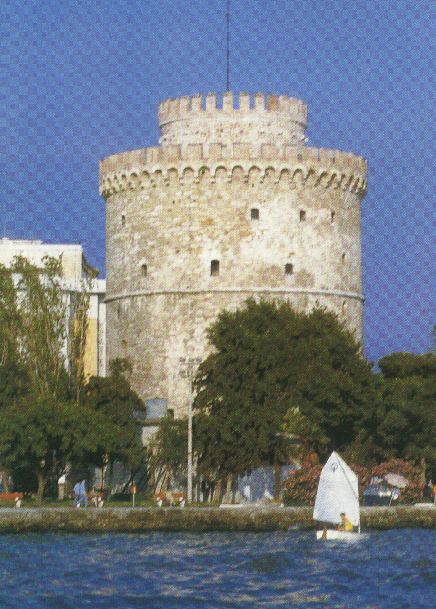 To Map
To MapThessalonica
| In Thessalonica it's hard to find any footsteps of Paul in a couple of senses. First, the new city has been built on top of the old so there has been little archeological exploration, and second, there are no memorial churches or places commemorating Paul's sojourn there. But Alexander the Great is alive and well and living in Thessalonica. Our Hotel was just across the street from Aristotle Park at the end of Aristotle Street. Aristotle was from Macedonia and taught Alexander and Alexander's father, Phillip. Just beyond the park across Nikis Street is the beautiful waterfront promenade which seemed to extend for several miles past tour boats and marinas. As we began our walk on the Sunday afternoon we arrived, it was crowded up near the park, but it thinned out after we strolled past the monument to Alexander and the White Tower. A lone sailboat cruised the harbor. Thessalonica was founded in 315 BC E by Cassandra, Alexander's general and brother-in-law, and named for his wife, Alexander's step-sister, Thessaloniki. Since 168 B.C.E., it had been under control of the Romans, who deported the local population. Built around a natural harbor, the city thrived as the only port on the Via Egnatia, outstripped Athens during the Byzantine period, and even today is the second largest city in Greece after Athens. When Paul arrived he found a walled city of about 65,000 people, the largest city in and capital of Macedonia, and one of the largest cities in the Roman Empire. He would have entered the city through a gate on the Via Egnatia, still one of the main streets of the modern city, but he would not have passed under the Arch of Galerius, a triple Roman arch built about 305 C.E. by the Emperor Galerius. |  |
According to Acts 17:1-9, Paul visited a Synagogue and engaged the congregation in discussions about Jesus as the Messiah. This meant there was probably a large Jewish community here at the time. Even in 1936, the British travel writer, H. V. Morton, could write, "A feature of [Thes]Salonica that impresses the visitor are newspapers and advertisements printed in Hebrew characters. There is an enormous Jewish colony in the port, but I am told that it has decreased since the Greek occupation. In Turkish times Solonica was often called a Jewish city." (In the Steps of St. Paul, p. 283) By 1956, however, another travel writer, Robert Kinsey, wrote, "If Paul were to return to Salonica, he would find today very few Jews; during the German occupation of the Second World War, most of the Jews fled and have never returned." (With Paul in Greece, p. 55) Actually, our guide told us, the Nazi's deported the Jews to concentrations camps.
As a result of Paul's preaching, a few of the Jewish men, many of the leading women and numerous "god-fearing" Greeks were persuaded by Paul's message. Gaining adherents made the established community jealous so they recruited some local thugs to make trouble. They couldn't find Paul and his companions, so the mob dragged some of his followers before the authorities and accused them of "turning the world upside down . . . acting against the decrees of Caesar, saying there is another king, Jesus." (17:7). To avoid the trouble, Paul's friends helped him slip away in the night after only about three weeks in town.
From reading Paul's letter to the Thessalonians, written in 51 from Corinth, not long after leaving Thessalonica, it seems that he must have been there longer than three weeks and that most of his converts were working class pagans. He settled in and found work, "For you remember our labor and toil, brethren; we worked night and day, that we might not burden any of you, while we preached to you the gospel of God ( I Thess. 2:9)." He congratulates the assembly on their "work of faith, labor of love and steadfastness of hope (1:3)" and reminds them of their pagan past, how they "turned to God from idols, to serve a living and true God. (1:9)."
Thessalonica was the site of many cults, reflecting the cosmopolitan mix of the population. Archeology has uncovered places for worship of the Greek Pantheon, the Emperor, and cults such as those of Isis, Serapis, Osiris or Mithra. Adherence to the belief systems and ritual practices of these cults gave people identity, meaning and value. Shifting their allegiance "to serve a living and true God" meant, according to Neil Elliott, refusing "to participate in the intricate web of local cults that gave sacred legitimization to the empire." (Liberating Paul, p. 196) It seems like it would have taken an extended stay to establish a permanent community with deep commitments in such a social and religious environment.
We toured the city by bus and made several stops. One stop was at the beautiful Basilica of St. Demetrius, the patron saint of the city, who was a Roman officer martyred in 4th Century. We also visited the Monastery of Vlatadon, founded by two brothers from Crete in the 13th century, and rode along a stretch of the well preserved Medieval Wall of the city.To Bereoa 
